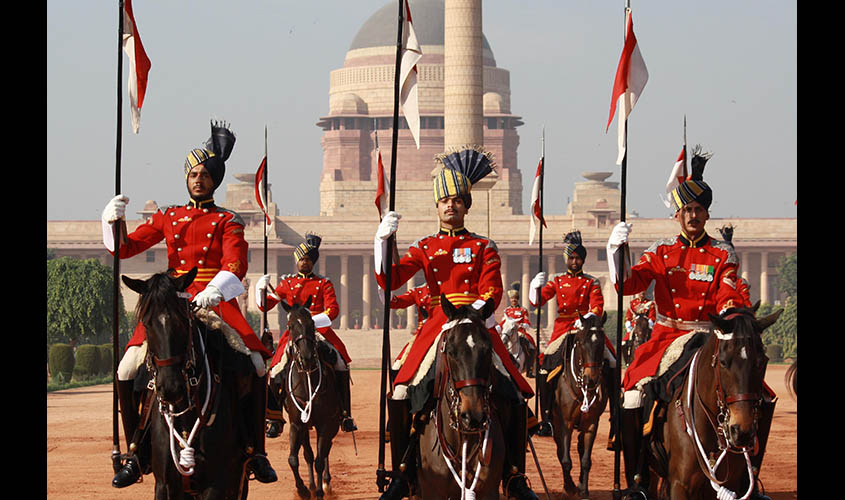‘Caste and President’s Bodyguards’
Watching the Republic Day parade this year reminded me how a recent Public Interest Litigation (PIL) claimed that certain castes are not considered for recruitment for the elite force of the President’s Bodyguard (PBG). The PBG is the oldest surviving mounted unit and the senior most regiment of the Indian Army, and except for the members of the martial races, others are not “entertained” for entry in this impressive contingent. A PIL filed in the Punjab & Haryana High Court has made serious allegations about the exclusion of certain castes from the process of recruiting PBGs. The whole issue has now come under the judicial scanner. Only, Ahirs, Jat Sikhs, Hindu Jats, Rajputs and Marathas are the castes that are apparently a part of this contingent, according to the petition.
As the petition has challenged the recruitment process in the country’s highest Constitutional office, the P&H High Court has asked the Additional Solicitor-General (ASG) of India to respond. Justice Rajan Gupta has fixed the case for further hearing as the ASG has sought instructions from the Union of India. The PIL has been filed by Manish Dayma of Gurugram (Haryana) against the Centre and other respondents. He has challenged an advertisement/notice dated 12 August 2017, which was published in a vernacular newspaper, on the ground that the President’s Bodyguard recruitment advertisement had “excluded” certain castes for applying for the posts. Justice Gupta, on a previous hearing, had asserted that the Bench was not inclined to issue notice at the current stage “as authenticity of the notice was required to be verified”.
Bodyguards’ history dates back to 1773
The present President’s Bodyguard (PBG) regiment is the successor of the Governor General’s Bodyguards of the British Raj. According to Sumit Walia, a noted military affairs writer, the PBG is the oldest surviving mounted unit and the senior most regiment of the Indian Army. In his well-researched piece in the Indian Defence Review, Walia says that the first form of PBG (then known as GGBG) was raised by Governor Warren Hastings in September 1773. Hastings handpicked 50 troopers from the “Moghal Horse”, which was raised in 1760 by local Sirdars—Sirdars Mirza Shahbaz Khan and Sirdar Khan Tar Beg.
In the same year, Raja Cheyt Singh of Benaras provided another 50 troopers that took the strength of the unit to 100. The first commander of the unit was Captain Sweeny Toone, an officer of the East Indian Company, (EIC) who had Lt Samuel Black as his subaltern.
The GGBG was the only Corps of cavalry in the Bengal presidency till 1777, when two Regiments of Cavalry were transferred to the EIC by Nawab of Oudh. Both the regiments were raised in 1776.
The President’s Bodyguard title kept on changing with the passage of time:
* 1773-1780: The Governor’s Troops of Moghals. Other titles in use were Troops of Bodyguard, Governor’s Troops of Bodyguards, Troops of Horse Guards, Troops of Black Cavalry, Body Troop. * 1784: Governor General’s Bodyguards (GGBG). * 1859: His Excellency the Viceroy’s Bodyguards. * 1944: 44th Divisional Reconnaissance Squadron (GGBG). * 1946: Governor General’s Bodyguard.
* 1947: After Independence, the unit got split between Governor General’s Bodyguard, India & Governor General’s Bodyguard, Pakistan. * 1950: The President’s Bodyguard, India. In Pakistan the title remained GGBG till 1956.
Before Independence, there were three more bodyguard units, one for each Presidency—Madras, Bombay and Bengal. These units were called Governor’s Bodyguard (and not Governor General’s Body Guards). All these units were disbanded in 1947. The GGBG first saw action in 1773-74 when it was deployed against Sanyasis—a band that ravaged the countryside in the guise of mendicants. Its next campaign was against Rohillas in April 1774 in the battle of St George, where the Rohillas were defeated completely. The Bodyguard was also present during the 3rd Mysore War (1790-92) against Tipu Sultan. During this campaign it successfully thwarted an assassination attempt on the life of Governor General Lord Cornwallis. In 1801, a detachment consisting of one Native Officer and 26 other ranks went to Egypt to provide riders for an experimental unit of horse artillery. It marched for 120 miles in the desert in the height of summer. All their horses died and they had to place the guns on camels. The Bodyguard detachment never saw action in Egypt as Alexandria had capitulated by the time that they arrived there.
The PBG has participated in many actions and won several awards. At present, the PBG cavalry regiment is considered as the senior-most in the order of precedence of the units of the Indian Army. The primary role of the President’s Bodyguard is to escort and protect the President of India. That is why the regiment is based in the Rashtrapati Bhavan in New Delhi. It is equipped as a mounted unit, with horses for ceremonies at the presidential palace and armoured vehicles for use in combat. The personnel of the regiment are also trained as paratroopers and nominally are expected to lead in airborne assaults in the role of pathfinders.
Recruitment to the PBG is extremely tough. All recruits are apparently from martial races of Ahirs, Jat Sikhs, Hindu Jats, Rajputs and Marathas. Before final selection, a thorough check is done by the Intelligence Bureau and the Military Intelligence into their background.
But now it has to be seen whether the President Kovind, being a Dalit, will be able to ask the defence authorities that “fit candidates” from all castes be considered for entry in the PBG.
Man Mohan can be contacted at rovingeditor@gmail.com

